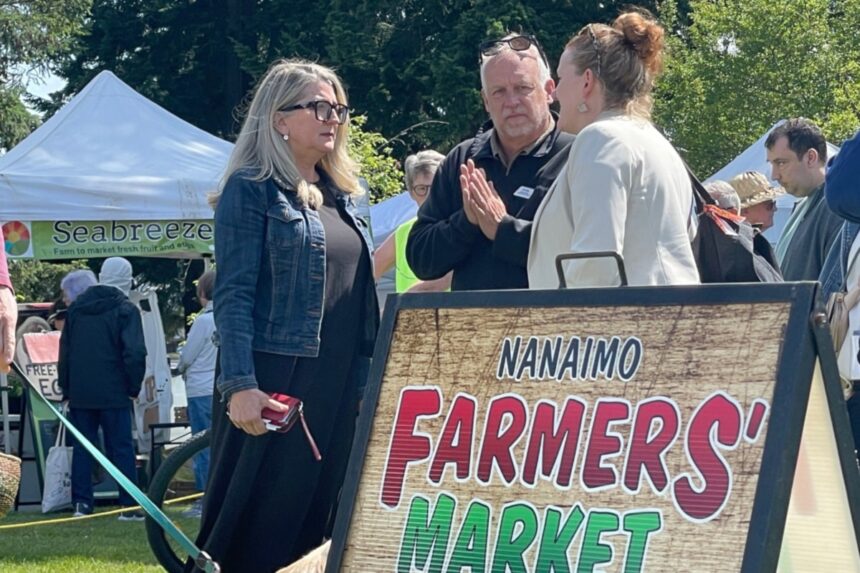The hum of activity at the Chilliwack Farmers Market last Thursday wasn’t just about fresh produce and artisanal goods. It marked a significant expansion of a provincial program that’s becoming a lifeline for thousands of British Columbians.
“For some families, this is the difference between having fresh vegetables and simply going without,” explained market manager Sarah Smith, gesturing toward a young mother carefully selecting local strawberries while her toddler sampled a piece of cheese from a nearby vendor.
The BC Farmers’ Market Nutrition Coupon Program has received a substantial boost for 2024, with the provincial government announcing an additional $3 million in funding. This expansion will help approximately 10,000 more households access nutritious, locally-grown food across the province.
Agriculture Minister Pam Alexis, visiting the Chilliwack market to highlight the program’s growth, emphasized its dual benefits. “This program creates food security for vulnerable British Columbians while supporting our local farmers and food producers,” Alexis said while touring vendor stalls alongside local community partners.
The program provides weekly coupons worth $27 to low-income families, pregnant individuals, and seniors. Participants can redeem these coupons for fresh vegetables, fruit, nuts, eggs, dairy, herbs, vegetable and fruit plants, and meats at their local participating farmers’ markets.
What began as a modest initiative in 2007 serving a handful of communities has evolved into a comprehensive food security program now operating in 100 communities across British Columbia. The province estimates that over 13,750 households—approximately 38,000 individuals—will benefit this year.
For Fraser Valley farmer Pete Johnston, who has sold his organic produce at the Chilliwack market for eight years, the impact is tangible. “I’ve watched the coupon program transform from a small initiative to something that keeps my business viable during challenging seasons,” Johnston said, arranging his display of rainbow chard and baby carrots. “These aren’t just transactions—they’re relationships with community members who might otherwise never become my customers.”
The program’s expansion aligns with troubling statistics from Food Banks Canada, which reported a 32% increase in food bank usage across the country last year. In British Columbia specifically, food banks served over 183,000 individuals in March 2023 alone—an increase of 22% from the previous year.
Community nutritionist Maria Gonzalez, who coordinates the coupon program for three Fraser Valley communities, notes that the benefits extend beyond immediate hunger relief. “We’re seeing participants develop cooking skills, try new foods, and build community connections at the markets,” she explained. “For isolated seniors or newcomer families, this becomes a weekly social outing with nutritional benefits.”
The program operates from June through November, coinciding with the peak growing season. Participating households receive coupons through community partners like family resource centers, public health units, and Indigenous organizations.
An independent evaluation conducted by the University of British Columbia in 2022 found that 82% of program participants reported eating more fruits and vegetables, while 76% said they learned about new foods and ways to prepare them. Perhaps most significantly, 71% indicated they felt more connected to their community through market visits.
While celebrating the expansion, some market vendors and community advocates point to persistent challenges. Housing costs in British Columbia remain among the highest in Canada, putting additional pressure on food budgets. Statistics Canada data shows that in 2023, the average British Columbia household spent approximately 15% of their disposable income on food—a figure that climbs dramatically for lower-income families.
“The coupon program is vital, but it’s one piece of a complex puzzle,” noted Brenda Lee, executive director of the Chilliwack Community Food Action Network. “We need comprehensive approaches to housing affordability, livable wages, and sustainable agriculture to truly address food insecurity in our communities.”
For participants like Chilliwack resident Maria Tran, a single mother of two working part-time while finishing her education, the immediate impact is what matters most. “Before receiving these coupons, I bought the cheapest food possible—usually processed, never local,” Tran shared while selecting fresh eggs from a vendor. “Now my kids are trying foods I never had access to growing up. The farmers know us by name. It feels dignified.”
The BC Association of Farmers’ Markets, which administers the program, reports that approximately $3.1 million in coupons was redeemed at local markets in 2023, creating significant economic stimulus for small-scale agriculture.
Heather O’Hara, the association’s executive director, points to research showing that every dollar spent at farmers’ markets generates over two dollars in local economic activity. “These coupons aren’t just feeding families—they’re helping sustain family farms and rural communities,” O’Hara said.
As Minister Alexis concluded her market tour, she acknowledged that food security remains a persistent challenge. “We know there’s more work to do, but programs like this demonstrate how thoughtful policy can address multiple challenges simultaneously,” she remarked.
Back at the strawberry stand, market manager Smith observed the subtle but meaningful exchanges happening throughout the market. “The beauty of this program is how invisible it is,” she noted. “Someone using coupons looks exactly like someone using cash or credit—there’s dignity in that equality. Everyone deserves access to the best food our region produces.”






